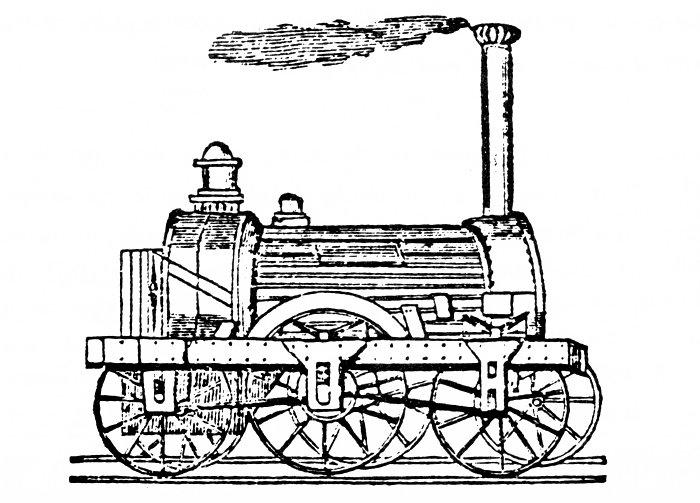The Fifth Edition
 |
Edition 5 contains the following articles: 'Great
Western Gallery', part 2 of 'Sins of The Fathers', a note on the L.N.W.R.
yard at Dudley, an article on GWR 2-4-0, "Barnums", 'Driver Smith and
G.W.R. locomotive number 30', Two Temporary Stations, 'Kings for
Repair', Working the 5.40a.m. to Kidderminster and the re-opening of the
Great Western public house. 'Great Western Gallery' consists of
photographs and a description of some noteable G.W.R. locomotives,
'Barnum' is a description of the G.W.R. 2-4-0 locomotives of that name
which were repaired at Stafford Road. 'Two temporary stations' is a
description of early S&B stations in Wolverhampton.
The cover photograph is of the oldest driver and stableman at
Wednesfield Road Goods Depot. |
Early Grand Junction
Locomotives
| The first official train to pass through Wolverhampton was drawn by the
locomotive 'Wildfire' on the opening of the railway in July 1837. There
were other engines at work along the line before this date however, a
recorded example being the trial Works of the American built Norris
locomotives of the Birmingham and Gloucester Railway, prior to the
opening of the line for regular use. 'Wildfire' was one of a series of somewhat similar 2-2-2 locomotives
built over the period 1837 to 1840 by various manufacturers, being
numbered 8 on the company list. We are fortunate in that a period model
of the locomotive still exists, as does an early drawing, though this
shows detail differences compared to the model. These early engines
suffered from constant failures of the inside cranks and motion, and
were converted to outside cylinder Crewe types as circumstances
permitted. 'Wildfire' was possibly so rebuilt in October 1844, but was
sold to the Liverpool, Crosby and Southport Railway in 1855. The exact
nature of these rebuilds is still a subject for discussion. Exactly how
much, or how little, of the original engines remained after such a
radical alteration is open to question.
|

A contemporary model of G.J.R. number 8
'Wildfire', which drew the first train through Wolverhampton
station. 'Wildfire' covered a total of 118,000 miles before
withdrawal, the greatest mileage of any engine in the class. |
| As 'Wildfire' is credited with working the first
train through Wolverhampton from Birmingham, so 2-2-2 No. 3 is
credited elsewhere as drawing the ‘first train’, presumably from
north to south. ‘Shark’ was of the same standard design as
'Wildfire', both being built by the Robert Stephenson Co. with 5ft
driving wheels, 3ft 6in. leading and trailing wheels, cylinders
12.5in x 18 in. and boiler 3 ft 3 in. x 8 ft. Between 8th July and
30th September 1837, 'Shark' ran a recorded distance of 10,018
miles, and was still in good order. ‘Shark’ was rebuilt, (replaced?)
as a Crewe type outside cylinder locomotive in January 1845. Driving wheels were now 5ft. 6in., cylinders 13 x 20 in. The engine was
withdrawn from the L.N.W.R. in 1854 and purchased for contracting use by
Isaac Boulton Engineering of Ashton-Under-Lyne. It was recorded there as
having an ornamental chimney (probably Webb type) and sloping cylinders.
As these ornamental caps were not introduced until 1857, and the engine
was withdrawn from the L.N.W.R. in 1854, this observation is rather
suspicious.
'Shark' was worn out by the 1860s, and after several more jobs, was
broken up. The motion and connecting rods, all of the Trevithick
pattern, were stamped 'Shark' and lay around Boulton's shops for years
afterwards. The name-plates were mounted on the walls in the works with
other obsolete locomotives memorabilia, though no record remains of what
was once preserved there. The only known illustration of 'Shark' was
that engraved into each of a pair of matching flint-lock pistols
presented to W. Boulton senior on the occasion of his becoming a G.J.R.
stationmaster at the opening of the line. These have also vanished into
history. |
|

The period drawing shows another engine of
the same series as 'Wildfire'. |
| As we saw in our last issue, all trains stopped at
Wolverhampton to receive coke and water, and to have their wheels
and motion greased, examples of engines so recorded are 'Eagle',
'Oberon', 'Medea', 'Basilisk', 'Shark', 'Lynx', and 'Prospero'. The
locomotives 'Lynx' and 'Prospero' for instance, working from
Birmingham to Wolverhampton, 'Lynx' and 'Eagle' from Wolverhampton
to Whitmore and 'Lynx' only to Warrington. Reading through the catalogue of locomotive names originating on the
Grand Junction Railway, and later inherited and perpetuated by the
L.N.W.R., one can only be struck with admiration at such imagination and
originality: 'Sunbeam', 'Vampire', 'Talisman', 'Oberon', 'Harlequin',
'Medusa', 'Lucifer', 'Columbine', these were the heralds of a new age.
If such titles now seem out of place, set upon such diminutive machines,
it is surely that our senses are dimmed by all that has happened since.
In their day such machines enabled men and women to travel three times
faster than at any time in previous history, even Concorde can claim no
such ratio of acceleration. |

|
|

|
|

|
| Return to
Edition 4 |
|
Return to
the Beginning |
|
Proceed to
Edition 6 |
|